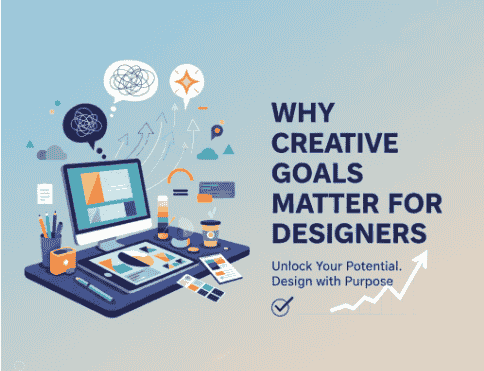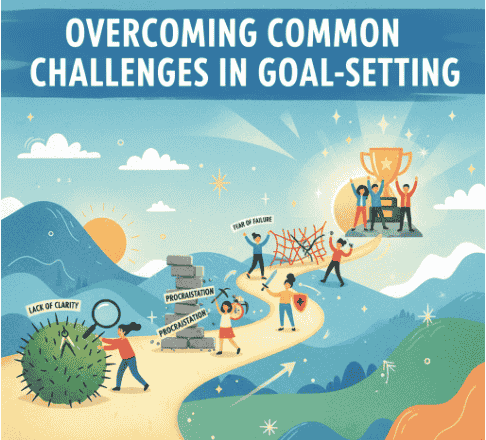Table of Contents
- Introduction
- Why Creative Goals Matter for Designers
- Key Types of Creative Goals for Designers
- Skill Development Goals
- Portfolio Building Goals
- Career Advancement Goals
- Personal Creative Growth Goals
- The SMART Method for Setting Creative Goals
- Step-by-Step Guide to Achieving Design Goals
- Tools, Resources, and Learning Platforms
- Overcoming Common Challenges in Goal-Setting
- Real-World Examples of Creative Goals in Action
- Enhancing Your Creative Work with Typography
- Conclusion
- References
1. Introduction
Designers thrive when they set clear, actionable objectives. Without direction, even skilled creatives may struggle to progress. That’s why creative goals for designers are essential. These goals not only guide your learning but also keep your career moving forward, helping you master new tools, strengthen your portfolio, and find creative fulfillment.
2. Why Creative Goals Matter for Designers
Creative goals provide structure and motivation. According to Harvard Business Review, setting specific goals improves performance and productivity across all industries, including design.
Benefits include:
- Clarity of vision: Goals act as a roadmap to define what you want to achieve.
- Skill expansion: Structured learning objectives help you adapt to design trends.
- Career momentum: Professional milestones, like updating a portfolio, make you more competitive in the job market.
- Personal satisfaction: Goals keep passion alive by aligning creative output with personal growth.

3. Key Types of Creative Goals for Designers
Skill Development Goals
Design tools and technologies evolve quickly. A skill-focused goal could be:
- Learning 3D modeling in Blender within six months.
- Mastering advanced typography and pairing techniques.
- Exploring AI-assisted design workflows.
Portfolio Building Goals
Your portfolio is often the first impression you make. Examples of portfolio goals:
- Redesigning your online portfolio once every 18 months.
- Adding at least 3 new projects that showcase diverse design styles.
Career Advancement Goals
Whether freelancing or climbing the corporate ladder, career goals might include:
- Landing your first international client.
- Transitioning into a senior design role.
- Expanding your services into branding or UX design.
Personal Creative Growth Goals
Passion projects are equally valuable. They might not always be client-driven, but they foster creativity:
- Designing a personal typeface.
- Starting a design blog to share insights.
- Participating in daily or weekly creative challenges.
4. The SMART Method for Setting Creative Goals
Using the SMART framework helps ensure your goals are achievable:
- Specific: Define the exact skill or milestone.
- Measurable: Track progress with metrics (e.g., “Complete 10 case studies”).
- Achievable: Set goals within realistic limits.
- Relevant: Align goals with your career aspirations.
- Time-bound: Attach a deadline, such as “by the end of the year.”
This method is widely endorsed in productivity and creativity studies (MindTools).
5. Step-by-Step Guide to Achieving Design Goals
- Identify Priorities – Start with the most impactful goals.
- Break Down Big Goals – Divide into smaller milestones.
- Schedule Consistently – Dedicate set times each week.
- Track Progress – Use journals, Notion, or Trello.
- Seek Feedback – Join design communities like Dribbble or Behance.
- Celebrate Achievements – Acknowledge progress to stay motivated.
6. Tools, Resources, and Learning Platforms
- Learning: Skillshare, Domestika, Coursera for structured courses.
- Inspiration: Pinterest, Behance, Awwwards.
- Organization: Trello, Asana, Notion for tracking goals.
- Typography & Fonts: RaisProject Fonts offers curated collections that fit different creative goals, from bold retro projects to modern branding work.
7. Overcoming Common Challenges in Goal-Setting
- Creative Blocks: Try setting micro-goals like “design one poster daily.”
- Procrastination: Use accountability partners or tools like Focusmate.
- Resource Gaps: Explore free online tutorials and open-source design tools.
- Burnout: Balance work goals with personal creative projects.
According to the American Psychological Association, balancing challenging yet achievable goals reduces stress and increases long-term success (APA).

8. Real-World Examples of Creative Goals in Action
- Daily Logo Challenge: Designers commit to producing one logo every day for 50 days.
- Typography Mastery Projects: Some dedicate six months to mastering a particular font style or lettering technique.
- Passion Side Projects: Creating personal branding mockups or experimenting with font combinations like Vintage Sign Painting Fonts or Timeless Script Fonts.
9. Enhancing Your Creative Work with Typography
Typography is central to visual communication, and choosing the right fonts supports your design goals.
- For retro-inspired projects, consider Bold Retro Fonts.
- For modern branding work, use Minimal Sans Serif Fonts.
- For handcrafted or passion projects, experiment with Handwritten Fonts.
Fonts shape perception, evoke emotion, and define style—making them essential tools in achieving design goals.
10. Conclusion
Creative goals for designers are not just wishful thinking—they are practical, actionable strategies to direct your growth and creativity. By applying SMART methods, leveraging the right tools, and exploring professional resources like typography from RaisProject, designers can sharpen their skills, enrich their portfolios, and achieve both personal and professional milestones.
Your creative journey is a continuous process. Keep setting goals, stay consistent, and embrace every achievement as a stepping stone to your next level.
11. References
- Harvard Business Review: Goals That Work
- Interaction Design Foundation: Goal Setting in Design
- MindTools: SMART Goals
- American Psychological Association: Goal Setting Benefits

